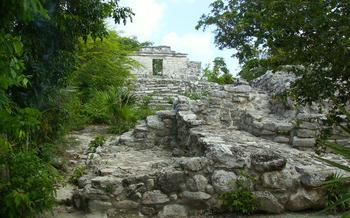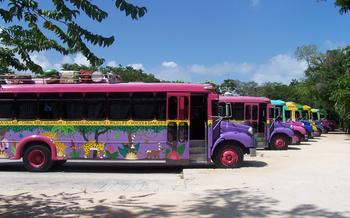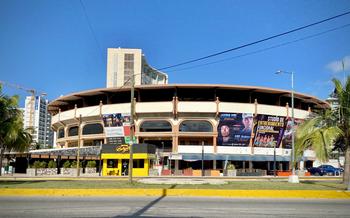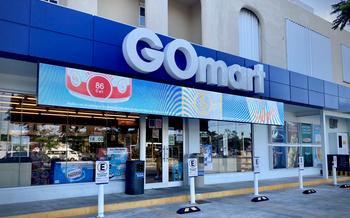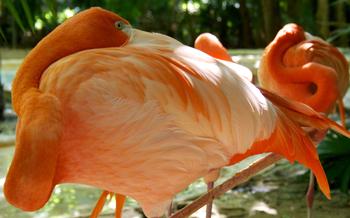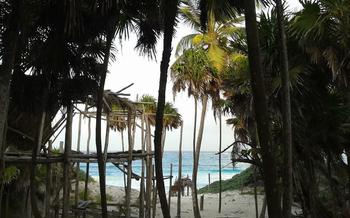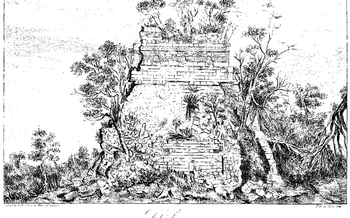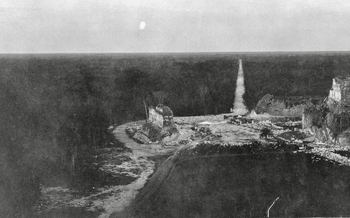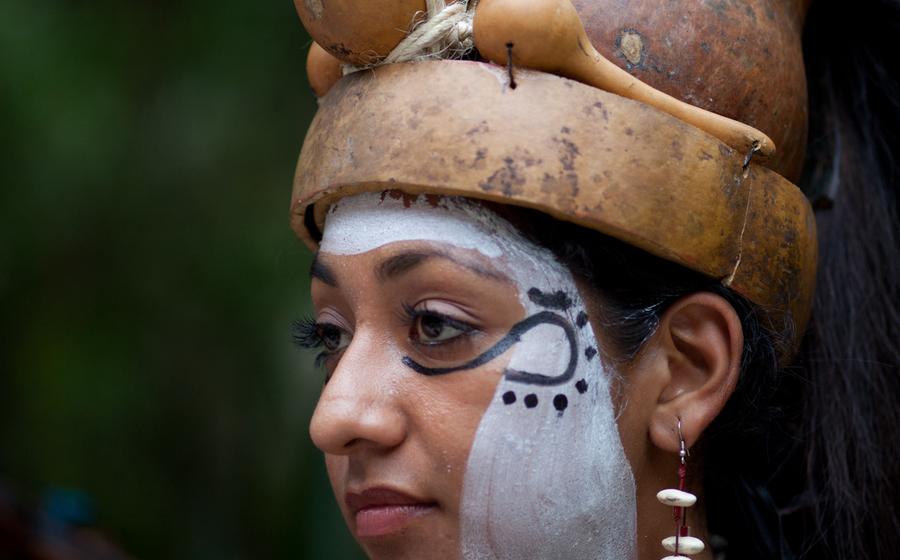
Museo Subacuático de Arte (MUSA)
- Xcaret and the Museo Subacuático de Arte (MUSA)
- MUSA Art Installations
- Marine Life
- Snorkeling and Diving at MUSA
- Best Time to Visit MUSA
- Entrance Fees and Tickets
- Facilities and Amenities
- Xcaret Park
- Tips for Planning Your Visit
- History of MUSA
- Why and when was MUSA created?
- What was the inspiration behind the project?
- How has it evolved over the years?
- What are the future plans for the museum?
- Additional Activities in Xcaret
- Local Cuisine and Dining Options
- Photography and Videography
- Sustainable Tourism
- Insider Tip: Unveiling the Hidden Wonders of MUSA
Xcaret and the Museo Subacuático de Arte (MUSA)
Xcaret is an eco-archaeological park on the Caribbean coast of Mexico, renowned for its natural beauty, Mayan ruins, and cultural attractions. Within Xcaret, the Museo Subacuático de Arte (MUSA) is an underwater museum that features over 500 sculptures submerged in the ocean, creating a breathtaking spectacle for snorkelers and divers. Whether you're an art enthusiast, marine life lover, or adventure seeker, Xcaret and MUSA offer a unique and unforgettable experience.
To reach Xcaret and MUSA, you can either drive or take a tour from nearby cities like Cancun or Playa del Carmen. The drive takes about an hour from Cancun, and tours typically include transportation, entrance fees, and snorkeling or diving equipment.
MUSA Art Installations
The Museo Subacuático de Arte (MUSA) boasts an impressive collection of over 500 sculptures, all created by renowned Mexican artists such as Jason deCaires Taylor, Salvador Quiroz Ennis, and Rodrigo Quiñones Reyes. These sculptures are made from a special type of concrete that is pH-neutral, non-toxic, and promotes the growth of coral.
The sculptures depict a variety of subjects, from human figures to marine life, and are arranged in underwater galleries and themed exhibitions. Some of the most notable works include "The Silent Evolution," a series of life-size sculptures that represent the evolution of humanity, and "The Coral Greenhouse," a group of sculptures that resemble a greenhouse filled with coral and other marine life.
The sculptures at MUSA are not only visually stunning but also serve an important purpose. They act as artificial reefs, providing a habitat for a variety of marine species and contributing to the restoration of the local ecosystem.
Visitors to MUSA can explore the underwater galleries by snorkeling or diving. Guided tours are available for those who wish to learn more about the sculptures and the marine life that inhabits the area.
Marine Life
MUSA is home to a diverse array of marine life, including over 500 species of fish, 60 species of coral, and numerous other invertebrates. The museum's unique underwater environment has attracted a variety of marine species, including parrotfish, angelfish, sea turtles, rays, and sharks. The museum's sculptures provide a habitat for these marine creatures, offering them shelter, food, and breeding grounds.
MUSA positively impacts the local ecosystem by promoting coral growth and providing a safe haven for marine life. The museum's sculptures act as artificial reefs, attracting fish and other marine organisms that contribute to the overall health and biodiversity of the reef system. The museum's conservation efforts include monitoring the health of the coral reefs, conducting scientific research, and educating visitors about the importance of marine conservation.
Visitors to MUSA can enjoy the unique opportunity to observe and interact with the diverse marine life in a natural setting. Snorkeling and diving at the museum offer an unforgettable experience, allowing visitors to swim among colorful fish, explore the underwater sculptures, and witness the beauty and fragility of the marine ecosystem.
Snorkeling and Diving at MUSA
The Museo Subacuático de Arte (MUSA) offers a unique opportunity for snorkeling and diving enthusiasts to explore the underwater world and admire the stunning art installations up close. The museum is home to over 500 sculptures, all created using materials that promote marine life growth and development.
Best Spots for Snorkeling and Diving
The Manchones Reef and the Nizuc Reef are considered the best spots for snorkeling and diving at MUSA. These areas offer clear visibility, calm waters, and a diverse range of marine life. Visitors can swim alongside colorful fish, sea turtles, stingrays, and even nurse sharks while admiring the underwater sculptures.
Equipment and Safety Guidelines
Snorkeling and diving equipment can be rented on-site, ensuring that visitors have access to high-quality gear. It is important to follow the safety guidelines provided by the museum, including wearing a life jacket, staying within designated areas, and respecting the marine life.
Organized Tours and Rentals
Guided snorkeling and diving tours are available for those who prefer a more structured experience. These tours often include equipment rental, instruction, and the opportunity to learn more about the art installations and the marine life at MUSA.
Whether you choose to snorkel or dive, exploring the Museo Subacuático de Arte is an unforgettable experience that combines art, nature, and adventure.
Best Time to Visit MUSA
The ideal time to visit MUSA is during the dry season, which runs from November to April. During this time, the weather is generally sunny and dry, with calm seas and excellent visibility underwater. The water temperature is also warmer during these months, making it more comfortable for snorkeling and diving.
Seasonal variations can affect the experience at MUSA. During the rainy season (May to October), there is a higher chance of rain and storms, which can reduce visibility and make snorkeling and diving more challenging. The water temperature can also be cooler during this time.
The time of day can also impact the experience at MUSA. The best time to visit is early in the morning or late in the afternoon, when the sun is not as strong and the water is calmer. This is also when the marine life is most active.
Weekdays are generally less crowded than weekends, so visitors may have a more peaceful and enjoyable experience if they plan their visit accordingly.
Entrance Fees and Tickets
Visiting MUSA requires an entrance fee, which varies depending on the package or ticket option chosen. The basic admission ticket includes access to the museum and snorkeling gear rental. For a more comprehensive experience, visitors can opt for guided tours or combo packages that include additional activities within Xcaret Park.
Prices:
- Basic admission: Approximately $25-30 USD
- Guided tours: Starting from $40-50 USD
- Combo packages (including Xcaret Park admission): From $80-120 USD
Discounts and Promotions:
- Discounts are available for children, students, and seniors.
- Combo packages often offer discounted rates compared to purchasing individual tickets.
- Keep an eye out for seasonal promotions and special offers.
Where to Purchase Tickets:
- Tickets can be purchased online through the official Xcaret Park website or authorized ticket vendors.
- It's advisable to book in advance, especially during peak tourist season, to avoid long lines and ensure availability.
Restrictions and Limitations:
- Some tours or activities may have age or height restrictions.
- It's important to check the specific terms and conditions of each ticket option before purchasing.
Facilities and Amenities
Xcaret provides visitors with a range of facilities and amenities to enhance their experience at the Museo Subacuático de Arte (MUSA). For the convenience of visitors, lockers are available for storing personal belongings, ensuring that valuables remain safe while exploring the underwater wonders. Additionally, showers and changing rooms are provided, allowing visitors to freshen up after their snorkeling or diving adventures.
For those seeking sustenance, a restaurant and cafe are located within the park, offering a variety of dining options to satisfy every palate. The menu features a selection of local delicacies, as well as international favorites, ensuring that visitors can indulge in a culinary journey while enjoying the breathtaking views of the Caribbean Sea.
Xcaret Park
Xcaret Park is a world-renowned eco-archaeological park located in the Riviera Maya, Mexico. It offers a wide range of attractions and activities for visitors of all ages, including the Museo Subacuático de Arte (MUSA). In addition to MUSA, Xcaret Park features a variety of other attractions, such as a Mayan village, an aquarium, a butterfly pavilion, and a cenote. Visitors to Xcaret Park can also enjoy a variety of cultural performances, live shows, and recreational activities, such as swimming, snorkeling, diving, and zip-lining.
MUSA can be visited separately from Xcaret Park, but it is also included in the park's admission ticket. If you are interested in visiting both MUSA and Xcaret Park, there are a number of combo tickets and discounts available. It is recommended to allocate a full day to explore both MUSA and Xcaret Park, as there is a lot to see and do.
Tips for Planning Your Visit
To make the most of your day at Xcaret and MUSA, plan ahead and arrive early to avoid crowds and long lines.
For snorkeling and diving, pack essentials like a swimsuit, towel, sunscreen, and a waterproof camera. Consider renting or bringing your own snorkeling or diving equipment.
Safety first! Wear appropriate footwear, stay hydrated, and be aware of your surroundings. Follow the guidelines and instructions provided by MUSA staff and tour operators.
Consider hiring a guide or taking a tour to enhance your experience. Guides can provide insights into the history, art, and marine life of MUSA.
History of MUSA
Why and when was MUSA created?
009 by the National Marine Park of Isla Mujeres, Cancún, and Punta Nizuc. The primary goal was to create an artificial reef to help restore and protect the Mesoamerican Barrier Reef, the second-largest coral reef system in the world. Additionally, it aimed to raise awareness about the importance of marine conservation and the threats facing the underwater world.
What was the inspiration behind the project?
The inspiration for MUSA came from the realization that traditional methods of reef conservation were not enough to protect the fragile coral reefs of the region. The museum's founders believed that creating a unique underwater art gallery could attract tourists and divers, generating revenue that could be used to fund conservation efforts and educate the public about the importance of protecting the marine environment.
How has it evolved over the years?
Since its inception, MUSA has grown significantly. The museum now features over 500 sculptures from various artists worldwide, creating an underwater wonderland that attracts visitors from around the globe. The museum has also become a popular spot for marine research and education, with scientists studying the impact of the sculptures on the local ecosystem and using the site to teach students about the importance of marine conservation.
What are the future plans for the museum?
MUSA continues to expand and evolve, with plans to add more sculptures and installations in the future. The museum is also working on developing educational programs and initiatives to engage visitors and promote marine conservation. Additionally, MUSA is exploring ways to use technology to enhance the visitor experience and make the museum more accessible to people worldwide.
Additional Activities in Xcaret
Beyond the Museo Subacuático de Arte, Xcaret Park offers a diverse range of attractions that cater to visitors of all ages and interests. For those seeking cultural immersion, the park features traditional Mexican performances, showcasing the vibrant dances, music, and folklore of the region. Visitors can also explore replicas of ancient Mayan ruins, offering a glimpse into the rich history and heritage of the area.
Families with children will delight in the Xcaret water park, boasting thrilling slides, splash pools, and interactive water features. Adventure enthusiasts can embark on exciting activities such as zip-lining through the lush jungle canopy, swimming with dolphins, or snorkeling in the crystal-clear waters of the park's natural underground rivers.
Throughout the year, Xcaret hosts special events and festivals that celebrate Mexican culture and traditions. These events often showcase live music, dance performances, traditional crafts, and culinary delights, providing visitors with an immersive and authentic experience of Mexican heritage.
Local Cuisine and Dining Options
Indulge in the tantalizing flavors of Xcaret's culinary scene, where local delicacies and international cuisine blend harmoniously. Savor the freshest seafood, including succulent shrimp and lobster, prepared with traditional Mexican spices and techniques. Don't miss the opportunity to try "cochinita pibil," a slow-roasted pork dish marinated in achiote paste, or "tacos al pastor," featuring spit-roasted pork served with pineapple and cilantro.
For a quick and refreshing bite, grab a "ceviche," a zesty seafood salad made with lime-marinated fish or shrimp. Vegetarians will delight in the variety of grilled vegetables, fresh salads, and flavorful vegetarian tacos.
Dining options near MUSA range from casual cafes to upscale restaurants. Enjoy a leisurely meal at one of the waterfront restaurants, where you can savor delicious food while taking in stunning views of the Caribbean Sea.
Visitors are welcome to bring their own food and drinks, but it's important to note that there are designated picnic areas within Xcaret Park. Please be mindful of the environment and dispose of waste responsibly to preserve the natural beauty of the park.
If you have dietary restrictions or preferences, such as vegan or gluten-free options, there are plenty of choices available at Xcaret's restaurants. The friendly staff is always happy to assist with any special requests.
Photography and Videography
Are cameras allowed at MUSA?
Yes, cameras are allowed at MUSA. Visitors are encouraged to capture their underwater experiences and share them with others. However, it is important to be respectful of other visitors and the marine life.
Are there any restrictions on photography or videography?
There are a few restrictions on photography and videography at MUSA. Visitors are not allowed to use flash photography, as this can disturb the marine life. They are also not allowed to use tripods or other large equipment that could damage the coral reefs.
Are there any designated spots for taking photos or videos?
There are a few designated spots at MUSA where visitors can take photos and videos. These spots are marked with signs, and they are located in areas where the coral reefs are not as fragile.
Can visitors share their photos and videos online?
Visitors are encouraged to share their photos and videos of MUSA online. However, they should be sure to tag the museum and use the hashtag #MUSA. This will help the museum to promote its conservation efforts and to reach a wider audience.
Sustainable Tourism
MUSA is committed to promoting responsible tourism practices that minimize environmental impact and protect the delicate marine ecosystem. The museum uses eco-friendly materials and techniques in the creation and maintenance of its sculptures. It also actively participates in conservation efforts, such as coral reef restoration projects and educational programs to raise awareness about the importance of preserving the underwater environment.
Visitors can contribute to sustainable tourism by following the museum's guidelines, such as avoiding touching or damaging the sculptures and respecting the natural habitat. They can also participate in conservation initiatives offered by MUSA, such as beach cleanups or coral planting activities. By minimizing their environmental impact and actively participating in conservation efforts, visitors can help ensure the long-term sustainability of MUSA and the surrounding marine environment.
Insider Tip: Unveiling the Hidden Wonders of MUSA
Amidst the mesmerizing underwater sculptures of MUSA, there lies a hidden gem waiting to be discovered by discerning travelers. Tucked away in a secluded corner of the museum, you'll find a captivating sight—a sculpture known as "The Dreamcatcher." This awe-inspiring artwork depicts a colossal dreamcatcher suspended gracefully among the coral reefs, its intricate web shimmering with an ethereal glow. As sunlight filters through the water, the dreamcatcher casts mesmerizing shadows, creating a truly magical experience. Don't miss this hidden treasure as you explore the depths of MUSA; it's a breathtaking reminder of the boundless creativity and wonder that await those who seek out the uncommon.

